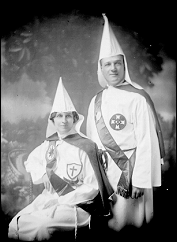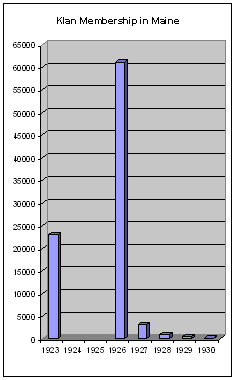was active in Maine during the 1920’s. Worried that foreign culture, religion, and politics would contaminate Anglo-American society, some Maine people did not want the new immigrants in the state and joined a rejuvenated Ku Klux Klan.
The Klan had been formed after the Civil War to keep freed African slaves from gaining political power. Officially disbanded in 1872, organizers reestablished the group in 1915 with the burning of the first fiery cross on Stone Mountain near Atlanta, Georgia. The new Klan was based on a debate over “Americanism”– what it meant to be an American and who deserved to be here. Thus, the Klan’s new agenda included hatred of foreigners.
The country was divided into eight “domains,” one of which was New England, and further into “realms” or states. Led by King Klegle F. Eugene Farnsworth of the Maine Realm, recruits targeted Catholics, Jews, and African Americans throughout the state. Farnsworth gained attention when he delivered his first lecture to the citizens of Portland on January 22, 1923.
Claiming anywhere from 20,000 to 50,000 members in 1924, though it rapidly lost ground in the next few years, Maine’s Ku Klux Klan presented itself as a respectable social club. The Klan’s leaders or “klegles” recruited ministers, politicians, doctors, and other members of the community who made the Klan seem reputable. The group also boasted an active women’s auxiliary called the Klaxima who gave parties, bazaars, Christmas socials, and bean suppers.
Although Klan members wore hoods that covered their heads, many Maine members were proud of their involvement, showing their faces and even posing for portraits. Yet the façade did not hide the Klan’s intent as they hatefully burned crosses and marched in parades trying to intimidate all but “100 percent Americans.” Passionate anti-Klan demonstrators attended most Maine rallies.
Fanning fears that immigrants might gain control of the U.S. government, the Maine Klan organized as a political party. Their platform included the argument that Catholics could not be loyal to the United States because they owed allegiance to the Pope. More conventional campaign issues included support for prohibition and a promise to clean up government. In the mid-1920s, their campaign succeeded as Klan-backed candidates became mayors, state legislators, and members of the school committees.
Franco-Americans fought Klan members in street demonstrations in Greenville, Fairfield, and on the bridge between Biddeford and Saco in 1924, according to the Bangor Daily News. The Klan had attacked them as members of the International Workers of the World, the I.W.W. or “Wobblies.” This union attempted to organize lumbermen and others to no effect, thanks in large part to the Klan.
Governor Percival Baxter hated the Klan, calling it “an insult and an affront to all Maine and American citizens.” But in 1924, Ralph O. Brewster succeeded him as governor, elected by a strong foundation of Klan support.
The Ku Klux Klan’s popularity in Maine was short-lived — by 1930 its membership had dwindled to less than 200. Led by nationwide anti-Klan crusades, state leaders campaigned against the group. Violent Klan activity in the South also tarnished the group’s image with its Maine members.
Finally, money played a part in the Klan’s downfall. King Klegle William Farnsworth had become wealthy collecting a “klecktoken” of ten dollars from each new recruit. As the depression hit, Maine people had less money to pay fees to a group whose cause they had begun to seriously question.
Additional resources
Breton, Rita Mae. RedScare: A Study in Maine Nativism, 1919-1925. 1972. (Thesis (M.A.) in History–University of Maine, 1972.) [University of Maine, Raymond H. Fogler Library, Special Collections; University of Southern Maine (Portland). The Albert Brenner Glickman Family Library.]
Center for Maine History, Maine Historical Society, “Maine Gone Mad” on-line exhibit. 2001.
Moores, Lawrence W., Jr. The History of the Ku Klux Klan in Maine, 1922-1931. Orono: University of Maine. 1950 (Masters Thesis) [University of Maine, Raymond H. Fogler Library, Special Collections; Maine State Library]
Whitney, Edward Bonner. The Ku Klux Klan in Maine, 1922-1928: A Study with Particular Emphasis on the City of Portland. 1966. (Thesis (B.S.)–Harvard College, 1966)





Being originally from Maine and now in Florida, this is part of the main history I had not studied. A very good article.
Especially with what is going on now days in Washington.